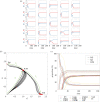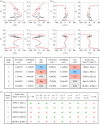Initial source of heterogeneity in a model for cell fate decision in the early mammalian embryo
- PMID: 35865503
- PMCID: PMC9184963
- DOI: 10.1098/rsfs.2022.0010
Initial source of heterogeneity in a model for cell fate decision in the early mammalian embryo
Abstract
During development, cells from a population of common progenitors evolve towards different fates characterized by distinct levels of specific transcription factors, a process known as cell differentiation. This evolution is governed by gene regulatory networks modulated by intercellular signalling. In order to evolve towards distinct fates, cells forming the population of common progenitors must display some heterogeneity. We applied a modelling approach to obtain insights into the possible sources of cell-to-cell variability initiating the specification of cells of the inner cell mass into epiblast or primitive endoderm cells in early mammalian embryo. At the single-cell level, these cell fates correspond to three possible steady states of the model. A combination of numerical simulations and bifurcation analyses predicts that the behaviour of the model is preserved with respect to the source of variability and that cell-cell coupling induces the emergence of multiple steady states associated with various cell fate configurations, and to a distribution of the levels of expression of key transcription factors. Statistical analysis of these time-dependent distributions reveals differences in the evolutions of the variance-to-mean ratios of key variables of the system, depending on the simulated source of variability, and, by comparison with experimental data, points to the rate of synthesis of the key transcription factor NANOG as a likely initial source of heterogeneity.
Keywords: bifurcation; cell differentiation; noise; probability distribution; tristability; variability.
© 2022 The Author(s).
Figures








Similar articles
-
Cell Fate Specification Based on Tristability in the Inner Cell Mass of Mouse Blastocysts.Biophys J. 2016 Feb 2;110(3):710-722. doi: 10.1016/j.bpj.2015.12.020. Biophys J. 2016. PMID: 26840735 Free PMC article.
-
Gata6, Nanog and Erk signaling control cell fate in the inner cell mass through a tristable regulatory network.Development. 2014 Oct;141(19):3637-48. doi: 10.1242/dev.109678. Epub 2014 Sep 10. Development. 2014. PMID: 25209243
-
Does mouse embryo primordial germ cell activation start before implantation as suggested by single-cell transcriptomics dynamics?Mol Hum Reprod. 2016 Mar;22(3):208-25. doi: 10.1093/molehr/gav072. Epub 2016 Jan 5. Mol Hum Reprod. 2016. PMID: 26740066
-
A close look at the mammalian blastocyst: epiblast and primitive endoderm formation.Cell Mol Life Sci. 2014 Sep;71(17):3327-38. doi: 10.1007/s00018-014-1630-3. Epub 2014 May 4. Cell Mol Life Sci. 2014. PMID: 24794628 Free PMC article. Review.
-
Mouse gastrulation: Coordination of tissue patterning, specification and diversification of cell fate.Mech Dev. 2020 Sep;163:103617. doi: 10.1016/j.mod.2020.103617. Epub 2020 May 27. Mech Dev. 2020. PMID: 32473204 Free PMC article. Review.
Cited by
-
Role of tristability in the robustness of the differentiation mechanism.PLoS One. 2025 Mar 19;20(3):e0316666. doi: 10.1371/journal.pone.0316666. eCollection 2025. PLoS One. 2025. PMID: 40106426 Free PMC article.
-
Computational insights in cell physiology.Front Syst Biol. 2024 Mar 13;4:1335885. doi: 10.3389/fsysb.2024.1335885. eCollection 2024. Front Syst Biol. 2024. PMID: 40809125 Free PMC article. Review.
-
AI-powered simulation-based inference of a genuinely spatial-stochastic gene regulation model of early mouse embryogenesis.PLoS Comput Biol. 2024 Nov 14;20(11):e1012473. doi: 10.1371/journal.pcbi.1012473. eCollection 2024 Nov. PLoS Comput Biol. 2024. PMID: 39541410 Free PMC article.
-
Uncovering candidate Nanog-Helper genes in early mouse embryo differentiation using differential entropy and network inference.Sci Rep. 2025 Jun 6;15(1):19975. doi: 10.1038/s41598-025-03956-y. Sci Rep. 2025. PMID: 40481039 Free PMC article.
References
Associated data
LinkOut - more resources
Full Text Sources
Research Materials

